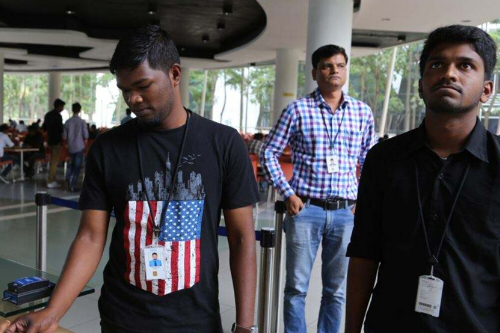India’s Diaspora: A Model Minority
印度移民:模范少数族裔
How Indians triumphed in America
印度人如何在美国获得成功
In the early 20th century just a few hundred people emigrated from India to America each year and there were only about 5,000 folk of Indian heritage living in the United States. That was more than enough for some xenophobes. A government commission in 1910 concluded that Indians were “the most undesirable of all Asiatics” and that the citizens of America’s west coast were “unanimous in their desire for exclusion”.
20世纪初,每年只有几百人从印度移民美国,生活在美国的印度裔仅有5000人左右。但这个数字对一些仇外人士来说已经不少了。一个政府委员会在1910年得出结论:印度人是“最不受欢迎的亚洲人”,且美国西海岸的公民“一致希望驱逐他们”。
Today Indian-born Americans number 2m and they are probably the most successful minority group in the country. Compared with all other big foreign-born groups, they are younger, richer and more likely to be married and supremely well educated. On the west coast they are a mighty force in Silicon Valley; well-off Indians cluster around New York, too. “The Other One Percent” is the first major study of how this transformation happened. Filled with crunchy analysis, it exudes authority on a hugely neglected subject.
今天,出生于印度的美国人有200万,他们可能是美国最成功的少数族裔。与其他所有生于外国的主要族裔相比,他们更年轻、更富有,已婚比例更高,并受过极好的教育。在西海岸,他们是硅谷的一股强大力量,而在纽约周边也聚集着富有的印度人。《另外百分之一》(The Other One Percent)是对这种转变的由来所做的第一项大型研究,充满了详实的分析,在这个被严重忽略的课题上尽显权威。
India’s diaspora is vast, with 20m-30m people spread across the world from the Caribbean to Kenya. In colonial times many moved as labourers after Britain abolished slavery in 1833, to build the east African railway, for example. In the 1970s a second wave of workers went to the Gulf during the oil boom. Perhaps the least well known flow of Indians abroad is the one to America. It picked up after 1965, when American immigration rules were relaxed, and surged after 1990. Three-quarters of the Indian-born population in America today arrived in the last 25 years.
印度移民人数众多,从加勒比到肯尼亚,全世界有2000到3000万印度移民分布各地。在殖民时期,许多印度人在1833年英国废除奴隶制之后作为劳动力移居海外,例如参与建造东非铁路的那些印度人。20世纪70年代,第二波移民工人在石油繁荣时期涌向了波斯湾。印度人移民美国的情况也许最不为人知。移民美国的人数在1965年美国放松移民规则之后开始增加,并在1990年以后飙升。如今,出生于印度的美国居民中有四分之三是在过去25年里移民而来的。

Like all immigrant groups, Indians have found niches in America’s vast economy. Half of all motels are owned by Indians, mainly Gujaratis. Punjabis dominate the franchises for 7-Eleven stores and Subway sandwiches in Los Angeles. The surge in Indians moving to America is also intimately linked to the rise of the technology industry. In the 1980s India loosened its rules on private colleges, leading to a large expansion in the pool of engineering and science graduates. Fear of the “Y2K” bug in the late 1990s served as a catalyst for them to engage with the global economy, with armies of Indian engineers working remotely from the subcontinent, or travelling to America on workers’ visas, to make sure computers did not fail at the stroke of midnight on December 31st 1999.
与所有移民群体一样,印度人在美国庞大的经济中找到了自己的位置。美国的汽车旅馆有一半为印度人所有,他们主要来自古吉拉特邦。来自旁遮普地区的印度人则经营着洛杉矶大多数的7-Eleven加盟便利店和赛百味三明治店。印度人涌入美国的浪潮也与科技产业的兴起密切相关。20世纪80年代,印度放松了对私立大学的规定,使得理工科毕业生人数激增。 20世纪90年代后期对“千年虫”的恐惧推动这些毕业生融入全球经济——大批的印度工程师要么在次大陆远程工作,要么持工作签证前往美国,以确保在1999年12月31日午夜时钟敲响时计算机不会瘫痪。
Today a quarter or more of the Indian-born workforce is employed in the tech industry. In Silicon Valley neighbourhoods such as Fremont and Cupertino, people of Indian origin make up a fifth of the population. Some 10-20% of all tech start-ups have Indian founders; Indians have ascended to the heights of the biggest firms, too. Satya Nadella, Microsoft’s boss, was born in Hyderabad. Sundar Pichai, who runs Google, the main division of the firm Alphabet, hails from Tamil Nadu.
今天,美国出生于印度的劳动力中有四分之一或更多的人在科技行业工作。在硅谷的弗里蒙特(Fremont)和库比蒂诺(Cupertino)等地区,印度裔人口占总人口的五分之一。大约10%到20%的科技创业公司有印度裔创始人,有些印度人还登上了最大型公司的高层之位。微软的老板萨蒂亚·纳德拉(Satya Nadella)出生在海德拉巴。Alphabet主要子公司谷歌的CEO桑达尔·皮查伊(Sundar Pichai)则来自泰米尔纳德邦(Tamil Nadu)。
The authors of “The Other One Percent” have been careful to avoid the trap of explaining Indians’ success in America through their particular culture. Instead they argue it is “at its core a selection story”. Indians cannot walk across a border to America. Because of the filters of caste, class and a fiercely competitive education system, only those with above average financial and human capital get the chance to move to America. Most have travelled either as students or holders of H1-B working visas, which require a university degree, and then acquire residency. This visa system acts as a further filter.
《另外百分之一》的作者小心避免了常见的陷阱,即从印度独特的文化这一角度来解释印度人在美国的成功。相反,他们认为这种成功的“核心就是一个筛选过程”。印度与美国不接壤,人们并不能直接穿越边境到美国。由于种姓制度、阶级分化和竞争激烈的教育制度的筛选,只有具备高于平均水平的财力和工作能力的人才有机会迁移到美国。大多数人都是持学生签证或是拥有大学学位才能获得的H1-B工作签证入境,然后获得居留权。这一签证制度起到了进一步过滤的作用。
Despite the light that the authors’ data-driven approach casts on this little-known story, there are some disadvantages. One is that it leaves little scope for exploring the dark side of India’s diaspora. Readers keen to peek at the underbelly should buy “The Billionaire’s Apprentice”, by Anita Raghavan, which was published in 2013. It is a brilliant account of the insider-trading ring that led to the downfall of Rajat Gupta, the former boss of McKinsey, a consulting firm. Fittingly he was pursued by a much-admired prosecutor of Indian descent.
尽管作者通过数据分析的方法让人们了解了印度移民鲜为人知的成功故事,但本书还是存在一些不足。一是它几乎没有花什么笔墨来探索印度移民的黑暗面。渴望一窥故事另一面的读者应该购买2013年出版、由阿妮塔·拉加万(Anita Raghavan)所著的《亿万富翁的学徒》(The Billionaire’s Apprentice)。这本书精彩地讲述了内幕交易圈的故事,咨询公司麦肯锡前老板拉贾特·古普塔(Rajat Gupta)正是因此下台入狱。对他提出起诉的是一位备受尊崇的检察官,也是印度裔。
But the authors do touch on the most fascinating question of all: how this gilded corner of the diaspora influences India itself. Diplomatic relations between the two giant democracies have long been testy. But in other realms the bond has grown closer. The stars at the pinnacle of American society are celebrated back in India alongside rather un-American figures such as spin-bowling masters and Bollywood maidens. The American-educated children of India’s governing elite probably helped push India to open up its economy in 1991. The tens of billions of dollars of income earned in America by India’s big technology firms is crucial for its balance of payments. And a new generation of entrepreneurs who have led a boom in e-commerce in India in the last five years are almost all American educated, or have worked for American technology firms.
但作者确实触及了一个最引人深思的问题:这些光鲜的印度移民是如何影响印度本国的。美印两大民主国家之间的外交关系长期以来一直颇为紧张。但在其他领域,两国间的联系已越来越紧密。那些在美国社会里地位崇高的印度名人在印度国内就和板球大师及宝莱坞美女等完全非美国的形象一样受到追捧。印度政界精英的孩子在美国接受教育,很可能是他们在1991年帮助推动了印度经济的开放。印度大型科技公司在美国所获的数百亿美元收入对印度的国际收支也至关重要。过去五年里引领印度电子商务蓬勃发展的新一代企业家几乎都受过美国的教育,或在美国科技公司工作过。
If, under its new president, America clamps down on immigration, the mutually beneficial movement of Indians will surely slow – they were the largest group of new immigrants in 2014, exceeding even arrivals from China and Mexico. That will be a loss, both to America and to India. In this new era of populism, “The Other One Percent” is a rigorous, fact-based analysis of how cross-border flows of brainy and ambitious people make the world a better place. Politicians and policymakers in both America and in India should make sure they read it.
如果新总统上任后美国收紧移民政策,令美印双方互利的印度移民潮肯定会放缓——印度人是2014年最大的新移民群体,人数甚至超过来自中国和墨西哥的移民。这对美国和印度都将是损失。在这个新的民粹主义时代,《另外百分之一》是一本论述严谨、以事实为依据的书,分析了富有头脑和雄心的跨国移民如何让世界变得更好。美国和印度的政客和政策制定者都应该好好读读。
英文、中文版本下载:http://www.yingyushijie.com/shop/source/detail/id/429.html








